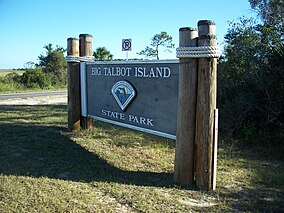Big Talbot Island State Park
| Big Talbot Island State Park | |
|---|---|
IUCN category IV (habitat/species management area) | |
 | |
| Location | Duval County, Florida, USA |
| Nearest city | Jacksonville, Florida |
| Coordinates | 30°28′59″N 81°26′24″W / 30.48306°N 81.44000°W |
| Established | 1982 |
| Governing body | Florida Department of Environmental Protection |
Big Talbot Island State Park is a
The park is a nature preserve and a location for nature study, bird-watching, or photography. Other activities include hiking, bicycling, fishing, boating, canoeing, kayaking, and picnicking. Amenities include picnic pavilions, nature trails, a fishing pier, a boat ramp, bike trails and beaches. The park is open from 8:00 am till sundown year round.
The coastal landscape and beach at Big Talbot Island is unique within the state of
Big Talbot and
Ecology
Habitats preserved by the park include beach, coastal scrub, coastal hammock, estuary, and tidal marshes. Parts of the salt marsh surrounding Big Talbot Island are included in the Machaba Balu Preserve.
Flora
Vegetation includes southern live oaks (
Fauna
This state park is home to
Gallery
-
Branches on the beach are common.
-
Picnic shelter and deck - Big Talbot Island
-
Blackrock Beach - Big Talbot Island
-
Unique hardpan formations - Blackrock Beach
-
Spiders above the Blackrock Trail - Big Talbot Island
-
Golden silk (Banana) spider - Big Talbot IslandGolden silk orb-weaver
-
Spurred butterfly pea (Centrosema virginianum)
-
Railroad Vine - Big Talbot Island Beach morning glory
References
- ^ Fodor's Florida 2014 0770432573 Big Talbot, with its Boneyard Beach of wind-twisted trees,is not recommended for swimming but is a photographer's paradise. .
- ^ Popular Photography - febr. 2007 - Page 34 "FLORIDA: A GUIDE TO NATURE AND PHOTOGRAPHY by John Netherton (Cumberland Valley Press, 1990). Out of print ... HIGHLIGHTS: Boneyard Beach is littered with tree skeletons. "
- ^ Blair Witherington, Dawn Witherington Living Beaches of Georgia and the Carolinas 1561644900 - 2011









